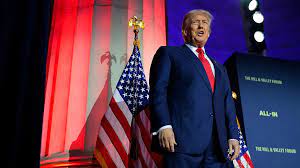The complex relationship between CNN and Trump has become one of the most defining media narratives of modern American politics. From heated exchanges to relentless coverage, this dynamic has reshaped public discourse and highlighted the evolving role of the media in democracy. In this article, we take a comprehensive look at the history, controversies, and influence surrounding the CNN Trump saga.
The Origins of the CNN Trump Relationship
Before his presidential bid, Donald Trump was a frequent guest on television, including CNN. He was often invited for his outspoken views and entertainment value. However, the relationship between CNN and Trump shifted dramatically once he announced his candidacy for president in 2015.
CNN, like many other news outlets, initially gave Trump extensive coverage. His rallies, speeches, and interviews were broadcasted widely, which many critics argue contributed to his rapid rise in popularity. Trump himself acknowledged the media exposure, often boasting about the ratings he brought.
Campaign Coverage and Media Strategy
As the 2016 campaign progressed, Trump began targeting CNN specifically, accusing the network of biased reporting. He frequently labeled CNN as “fake news,” a term that became central to his communication strategy. Trump’s direct confrontation with the press, especially CNN, energized his base and created a polarizing environment.
CNN, for its part, ramped up its fact-checking and analysis of Trump’s statements. The network featured numerous panels and investigative reports aimed at holding him accountable. This adversarial stance made CNN a favorite target during Trump’s rallies, where chants of “CNN sucks” became common.
Post-Election Escalation: CNN vs Trump in the White House
Once Trump assumed office in 2017, the relationship between CNN and the Trump administration deteriorated further. Daily press briefings often featured sharp exchanges between Trump’s press secretaries and CNN correspondents, particularly Jim Acosta.
One of the most publicized clashes occurred in 2018 when the Trump administration revoked Acosta’s White House press pass. CNN sued the administration, citing First Amendment rights. The court ruled in CNN’s favor, reinstating Acosta’s credentials. This legal battle underscored the tensions between the executive branch and the free press.
The Role of CNN in Investigative Journalism
During Trump’s presidency, CNN pursued numerous investigative stories related to Russian interference, impeachment proceedings, and controversial policies. While supporters of Trump accused CNN of perpetuating a negative agenda, defenders praised the network’s commitment to scrutiny and accountability.
The CNN Trump coverage also led to numerous viral moments—interviews, leaked documents, and whistleblower testimonies—that shaped public perception. Even those outside the U.S. closely followed these developments, making the CNN Trump discourse a global topic.
Trump’s Response and Media Strategy
Donald Trump, a master of branding and media manipulation, capitalized on his rivalry with CNN. He used his Twitter platform to criticize the network frequently, positioning himself as a victim of media bias. His supporters embraced this narrative, seeing CNN as part of a broader “mainstream media elite” working against him.
The phrase “enemy of the people,” which Trump used to describe CNN and similar outlets, sparked global concern among journalists and human rights organizations. Many warned that such rhetoric could endanger reporters and undermine democratic values.
CNN’s Editorial Shifts Post-Trump
After Trump left office in 2021, CNN underwent notable editorial shifts. The network faced criticism from both sides—some felt it had become too opinionated during the Trump era, while others argued it wasn’t aggressive enough. New leadership at CNN promised a return to more balanced journalism, reducing partisan commentary and focusing on fact-based reporting.
Despite these changes, the CNN Trump narrative continues to shape the network’s identity. The Trump presidency, filled with controversy and media spectacle, became a defining chapter in CNN’s modern history.
The Broader Media Landscape
The CNN Trump relationship is emblematic of a broader transformation in the media industry. With the rise of social media, cable news, and partisan echo chambers, the line between journalism and entertainment has blurred. Viewers now gravitate toward networks that align with their beliefs, deepening political divides.
CNN, once seen as a centrist news outlet, is now perceived by many as part of the liberal media. Trump’s attacks on the network solidified this image among conservatives, even as CNN executives insist on their commitment to impartial journalism.
Public Perception and Polarization
Surveys show that public trust in media has declined significantly since the Trump era began. CNN’s audience has become more partisan, with many Republicans abandoning the network entirely. At the same time, Democrats increasingly see CNN as a counterweight to right-leaning outlets like Fox News.
This shift highlights a critical issue: the growing divide between Americans not just in politics but in the sources of information they trust. The CNN Trump dynamic is at the heart of this split, influencing how millions interpret news and events.
Looking Ahead: What’s Next for CNN and Trump?
With the 2024 election behind and Trump continuing to be a dominant political figure, the CNN Trump saga is far from over. Whether he runs again, launches a media platform, or continues to influence Republican politics, Trump will remain newsworthy. And CNN, along with other media outlets, will continue covering him—though perhaps with lessons learned from the past.
CNN’s future coverage of Trump may lean more cautiously, focusing on fact-checking without amplifying misinformation. Meanwhile, Trump’s ongoing criticisms of the network ensure that their mutual influence on one another will remain significant in American media.
Conclusion
The CNN Trump relationship is more than a media feud—it’s a reflection of deep cultural, political, and institutional tensions within the United States. From fiery press conferences to legal battles, the story of and encapsulates the challenges of journalism in the digital age. As the landscape continues to evolve, this high-stakes rivalry will likely serve as a case study in media, power, and public perception for years to come.

